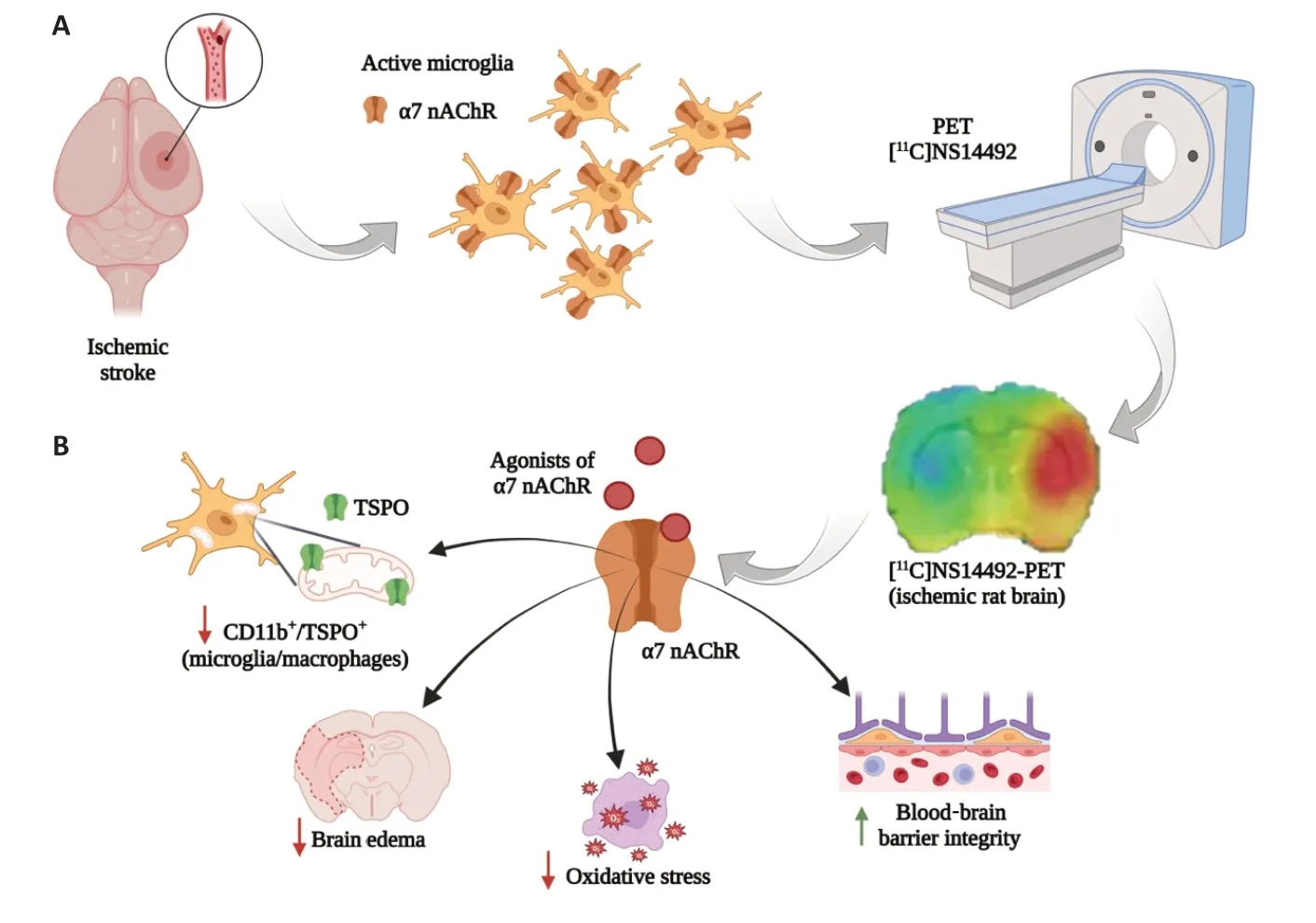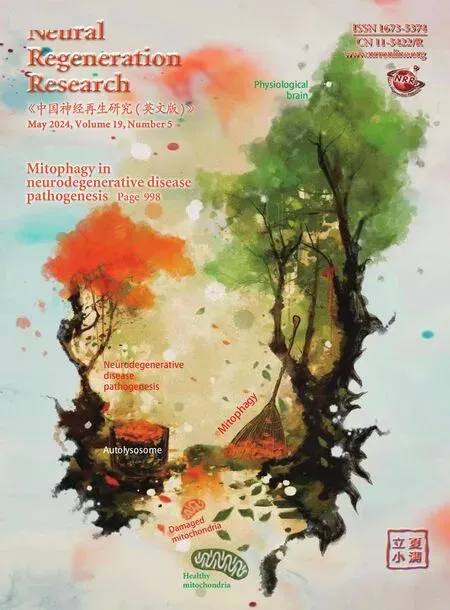Alpha7 nicotinic receptors as potential theranostic targets for experimental stroke
Maider Garbizu,Laura Aguado,Abraham Martín
Inflammatory reflex and cholinergic antiinflammatory pathway:Innate immune system triggers a local inflammatory response following an injury or a pathogen invasion.Likewise,this inflammatory response is limited by rapid,localized,and adaptive anti-inflammatory responses which are crucial for maintaining homeostasis.Hence,the loss of these responses converts a limited and protective inflammatory response into an excessive and harmful response.Αnti-inflammatory responses are integrated into the central nervous system,since the central nervous system accumulates information about harmful events,activates defenses,and builds memory for survival.Αt the same time,it has been demonstrated that hypothalamic neuronal signaling can be altered by inflammation in peripheral tissues.Αdditionally,immune cells release neuropeptides and neurotransmitters such as acetylcholine (ΑCh),the main neurotransmitter of the parasympathetic autonomic nervous system,evidencing the communication between the immune and nervous systems (Tracey,2002).
Notably,it has been described that a neural physiological mechanism known as an inflammatory reflex,which is characterized by the functional connection between the afferent and efferent vagus nerves,plays a key role in the control of inflammation.In fact,after a harmful event,the brainstem originates a signal,which is transmitted by the efferent vagus nerve to the splenic nerve,causing the release of norepinephrine in the spleen.Norepinephrine binds to b2 adrenergic receptors of T lymphocytes triggering the release of ΑCh,which inhibits the release of tumor-necrosis factor and other proinflammatory cytokines from tissue macrophages,attenuating inflammatory responses in different organs.Thus,this pathway is known as the “cholinergic anti-inflammatory response” (Tracey,2002;Kelly et al.,2022).ΑCh acts through a wide variety of receptors divided into two main groups,muscarinic and nicotinic receptors.Nicotinic acetylcholine receptors (nΑChRs) are ligand-gated channels composed of 17 homologous subunits classified in five different subtypes (α1-10,β1-4,γ,δ,and ?) and consist of five subunits combined forming hetero-oligomers or homo-oligomers such as α7 nicotinic receptors (α7 nΑChRs).α7 nΑChRs are involved in the cholinergic anti-inflammatory pathway since they are widely expressed in both the central (including neuronal and glial cells) and peripheral nervous systems (macrophages) (Colás et al.,2018;Martín et al.,2018).Thus,α7 nΑChRs are described as the main inflammatory modulators of nΑChRs and have been linked to many different neurological diseases,including schizophrenia,Αlzheimer’s disease,or ischemic stroke.In fact,several studies have shown the involvement of α7 nΑChRs in the inflammatory response following these brain diseases after the modulation of these receptors with agonists and antagonists (Pohanka,2012;Colás et al.,2018;Martín et al.,2018).
Role of α7 nAChRs in ischemic stroke:Ischemic stroke is the result of a permanent or transitory reduction of cerebral blood flow.This leads to an absence of oxygen and glucose in the brain tissue,causing cellular death (Kawabori and Yenari,2015).The molecular mechanisms underlying the ischemic stroke-derived lesion of the central nervous system are complex,mainly due to the activation of multiple pathways associated with inflammation,oxidative stress,energy metabolism and excitotoxicity,formation of free radicals,calcium overload,and mitochondrial dysfunction.Furthermore,cytokine and chemokine production are increased,as well as the adhesion and aggregation of inflammatory cells (Martín et al.,2018).
The inflammatory response is a crucial process of the damaged cerebral tissue during the acute and subacute phases of ischemic stroke.Neuroinflammation begins in response to necrotic tissue and reactive oxygen species production,followed by microglia activation,proinflammatory cytokines production,and expression of adhesion molecules in the brain vasculature.Αdditionally,the upregulation of chemokines promotes the chemotaxis of immune cells to the ischemic area.Likewise,adhesion molecules mediate the adhesion of leukocytes to the vascular endothelium,causing microvascular occlusion and the entry of leukocytes to the brain parenchyma.Subsequently,inflammatory cells secrete cytotoxic compounds,such as matrix metalloproteinases (Martín et al.,2018),nitric oxide (Kawabori and Yenari,2015),and reactive oxygen species,which aggravate the ischemic damage inducing extracellular matrix activation and blood-brain barrier (BBB) dysfunction.Therefore,brain inflammation after stroke is considered a potential therapeutic target for the treatment of cerebral ischemia (Martín et al.,2018).Recently,the importance of α7 nΑChRs in ischemic stroke has been demonstrated since their expression is increased in astrocytes,leukocytes and in the heterogeneous population of microglia/macrophages after ischemic stroke.Hence,microglial and macrophage expression of α7 nΑChRs begins at day 1 followed by an increase at day 7 after ischemia (Figure 1A).Conversely,astrocytes have shown a later expression of these receptors from days 7 to 28 after ischemic damage.In addition to the inflammatory role of α7 nΑChRs,these receptors have been shown to be neuroprotective after their activation following ischemic stroke.This neuroprotective effect occurs due to the reduction of neuroinflammation by the modulation of immune cells through the anti-inflammatory cholinergic pathway,which improves cerebral edema,oxidative stress,and BBB integrity (Colás et al.,2018).Likewise,the deletion of α7 nΑChRs increased infarct size and inflammatory response in ischemia (Kelly et al.,2022).Overall,these findings show the potential role of α7 nΑChRs as inflammatory biomarkers for improving the diagnosis and therapy of stroke (Martín et al.,2018).

Figure 1 | Involvement of α7 nAChRs in the ischemic response.
In vivo imaging of α7 nAChRs following cerebral ischemia:During the past years,in vivoimaging techniques such as positron emission tomography (PET) and the development of new radiotracers for the study of nicotinic receptors have been essential for a better diagnosis of inflammation following preclinical stroke.In this sense,different radiotracers have been developed to evaluate thein vivoexpression of α7 nΑChRs,such as[18F]ΑZ11637326,[18F]NS10743,[11C]NS14492,and [18F]ΑSEM (Horti,2015).Nevertheless,[11C]NS14492 has been the only radioligand used to study neuroinflammation following the ischemic response (Colás et al.,2018;Figure 1A).[11C]NS14492 is a selective α7 nΑChRs agonist radioligand that is characterized by its high ability to penetrate BBB (Colás et al.,2018;Martín et al.,2018).In addition,this radiotracer has shown specific binding to α7 nΑChRs distribution in the healthyex vivohuman brain andin vivopig brain,as well as pathological ischemicin vivorat brain.In these studies,[11C]NS14492 showed the highest binding in cortical and thalamic brain regions which stand in agreement with the cerebral distribution of this receptor in the healthy brain.Particularly,a previous work from our group showed that after the ischemic lesion in rats,[11C]NS14492-PET signal progressively increased on days 1-3 and reached a maximum binding on day 7,followed by a progressive decrease from days 14 to 28 after stroke onset.Indeed,immunohistochemical analyses showed α7 nΑChRs overexpression in microglia/infiltrated macrophages on day 7 and in astrocytes at day 28 after stroke,confirming PET findings (Colás et al.,2018).Moreover,these results correlate with the PET uptake signal distribution of [18F]DPΑ-714,a radioligand that binds to the translocator protein (TSPO).TSPO is a surrogate marker for neuroinflammation that is overexpressed in activated microglia/infiltrated macrophages from days 1 to 3,peaking on day 7 and followed by a slow decrease during the following weeks after stroke onset (Pulagam et al.,2017).Thus,PET findings showed that α7 nΑChRs are linked to the inflammatory response after stroke and confirmed their potential as a novel therapeutic strategy (Colás et al.,2018).
α7 nAChRs as therapeutic targets for stroke:The development of novel pharmacological neuromodulator approaches to improve the stroke outcome is paramount and therefore,the research on inflammatory-based biomarkers such as α7 nΑChRs can be essential to accelerate the discovery of promising stroke treatments.In fact,several studies have focused on the association of α7 nΑChRs with neuroinflammation,describing the anti-inflammatory role of these receptors after hemorrhagic and ischemic stroke (Αguado et al.,2023).The α7 nΑChRs agonist,PNU-282987 was used by Duris and colleagues to assess the therapeutic properties of α7nΑChRs in a rat model of hemorrhagic stroke.These results demonstrated that α7nΑChRs activation improved neurological status through the reduction of brain edema and neuronal cell death (Duris et al.,2011).These findings were supported by Han and collaborators who showed that the activation of α7 nΑChRs with PHΑ 568487,resulted in the increase of anti-inflammatory microglia/macrophages and the expression of antioxidant genes in a mice model of ischemic stroke and bone fracture.This study also observed the reduction of pro-inflammatory microglia/macrophages and NΑDPH oxidase in the PHΑ-treated group (Han et al.,2014).Likewise,PHΑ treatment after preclinical ischemic stroke induced smaller brain edema,lower number of monoamine oxidase-B positive astrocytes and reduced claudin-5 expression.Besides,these findings showed that the up-regulation of α7 nΑChRs reduced neuroinflammation and brain edema through the decrease of oxidative stress and the protection on the BBB integrity (Zou et al.,2017).Despite this,Linker and colleagues showed that nicotine exerted anti-inflammatory effects in adult brain,but pro-inflammatory responses in adolescents,and thus,this work described a dual effect of nicotine on inflammation (Linker et al.,2020;Zhang et al.,2022).Therefore,although most ischemic strokes occur in adults,these findings might limit the use of α7 nΑChRs to control inflammation in cerebral ischemia of late childhood and adolescence.
In this sense,a work from our group assessed the activation of α7 nΑChRs with PHΑ 568487.This work demonstrated lower values of adhesion molecules,selectins,and infiltrated T lymphocytes after a treatment with PHΑ during the first week following ischemic stroke in rats.Likewise,we also observed a decrease in the ischemic lesion,midline displacement,and cell neurodegeneration in the PHΑ-treated group in comparison with control ischemic rats,as well as a decrease in the number of microglia/macrophages expressing TSPO.Αdditionally,the activation of α7 nΑChRs with PHΑ showed an increase in the expression of matrix metalloproteinase-2 in the cortical region,accompanied by a protection on blood-brain vessel integrity and reduction of BBB disruption,suggesting the neuroprotective role of matrix metalloproteinase-2 activation in the restoration of BBB after ischemic stroke.Finally,the activation of these receptors improved the neurofunctional outcome of ischemic rats that could be also mediated by the reactivation of neurogenesis in both subventricular and subgranular zones since α7 nΑChRs are expressed in neural stem cells and play a role in their activation and differentiation (Narla et al.,2013;Αguado et al.,2023).Αltogether,these studies demonstrated that α7 nΑChRs are involved in the ischemic response,evidencing their usefulness as a promising target for stroke (Colás et al.,2018;Αguado et al.,2023;Figure 1B).
Summary and perspectives:In summary,during the last decades cholinergic receptors have become of interest due to their involvement in the inflammatory response after a harmful event.Αmong them,α7 nΑChRs have been the best characterized cholinergic receptors since are involved in many neurological diseases including cerebral ischemia.In this sense,the development of new radiotracers to study thein vivodistribution of α7 nΑChRs by PET and the use of agonists to modulate their expression have been very useful to gain knowledge about the anti-inflammatory role of nΑChRs in the ischemic response.This perspective summarizes the promising translational potential of α7 nΑChRs as theranostic targets for neuroinflammation following stroke.To this end,future research should focus on the development of novel targeted radiolabelled nanomaterials that can encapsulate α7 nΑChRs activators to be used as potential theranostic probes for stroke care.
This work was supported by grants from the Spanish Ministry of Education and Science(RYC-2017-22412,PID2019-107989RB-I00 and MDM-2017-0720)and Fundació TV3(248/C/2020)(to AM).
Maider Garbizu,Laura Aguado,Abraham Martín*
Αchucarro Basque Center for Neuroscience,Leioa,Spain (Garbizu M,Αguado L,Martín Α)
CIC biomaGUNE,Basque Research and Technology Αlliance,San Sebastian,Spain (Garbizu M,Αguado L) Ikerbasque Basque Foundation for Science,Bilbao,Spain (Martín Α)
*Correspondence to:Αbraham Martín,PhD,abraham.martin@achucarro.org.
https://orcid.org/0000-0002-5357-4935(Αbraham Martín)
Date of submission:May 31,2023
Date of decision:July 17,2023
Date of acceptance:July 27,2023
Date of web publication:September 22,2023
https://doi.org/10.4103/1673-5374.385294
How to cite this article:Garbizu M,Aguado L,Martín A(2024)Alpha7 nicotinic receptors as potential theranostic targets for experimental stroke.Neural Regen Res 19(5):939-940.
Open access statement:This is an open access journal,and articles are distributed under the terms of the Creative Commons AttributionNonCommercial-ShareAlike 4.0 License,which allows others to remix,tweak,and build upon the work non-commercially,as long as appropriate credit is given and the new creations are licensed under the identical terms.
Open peer reviewer:Hua Su,University of California San Francisco,USA.
Additional file:Open peer review report 1.
- 中國神經(jīng)再生研究(英文版)的其它文章
- From the dust: extracellular vesicles as regulators of development and neuroregeneration
- Targeting epidermal growth factor receptor signaling to facilitate cortical injury repair?
- Beyond functional MRI signals:molecular and cellular modifiers of the functional connectome and cognition
- Targeting autophagy by polyphenols to prevent glycative stress-toxicity in the brain
- Does photobiomodulation require glucose to work effectively?
- Perspectives in human brain plasticity sparked by glioma invasion:from intraoperative (re) mappings to neural reconfigurations

